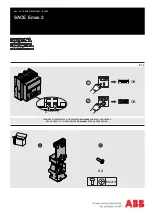
1 . Movable contact arm
2. Stationary main contact
3. Stationary arcing contact
4. Contact spring
5 . Arc rwrner
Fig. 5. AKRjAKRU-30 contact structure
(arc quencher removed)
5
3
The wipe adjustment influences proper arc trans
fer during interruption of fault currents. "Transfer"
of the arc is its forced sequential movement from
the intermediate contacts to the arcing contacts to
the arc rwrner and finally to the arc quencher where
it is dissipated and extinguished.
It
is recommended
that contact wipe be checked periodically during
normal maintenance inspections.
CAUTION:
BEFORE DOING ANY OF THE
FOLLOWING CONTACT ADJUSTMENT
AND REPLACEMENT WORK, MECHAN
ICALLY DISCONNECT THE CLOSING
SPRING FROM THE MECHANISM CAM
SHAFT. THE BREAKER CAN NOW BE
"SLOW-CLOSED" USING THE MAINTE
NANCE HANDLE.
CONTACT ADJUSTMENT
Types AKR-30, 30H
and AKRU-30
The contact arrangement of the 800 ampere
frame AKR and AKRU-30 breakers differs signi
ficantly from that of the AKR-50 frame size. Each
pole consists of a single movable contact arm acting
against five stationary contacts, arranged vertically
as shown in Fig. 5. Proceeding from top to bottom,
Power Circuit Breakers, GEI-86134
1 . Movable contact arm
2. Stationary main contact
3. Stationary arcing contact
Fig. 6. AKR-30H contact structure
the first two contacts serve as the arcing contacts
and the bottom three are the mains. There are no
intermediate contacts.
The contact assembly for the AKR-30H breaker
employs the same AKR/ AKRU -30 configuration, but
adds a fourth stationary main contact at the bottom.
See Fig. 6.
The following wipe adjustment procedure is ap
plicable to all AKR-30 types:
1. Open the breaker, remove arc quenchers.
2. Arrange the breaker for slow-closing as
described on Page 15 of GEK-7310A.
3. Using the ratcheting maintenance handle,
slow-close the breaker.
4. Select one pole and, using a flat or wire feeler
gage, measure the gap between the top contact and
its pivot stud as shown in Fig. 7. As necessary,
adjust the gap to 0.060
±
0. 020 inch by turning the
wipe adjustment stud.
5. Repeat this procedure on the other two poles.
6. Trip the breaker.
7
www
. ElectricalPartManuals
. com






































